Beko RCNE560E40DZXBN, RCNE560E40ZXBN User Manual

Refrigerator
User manual
Réfrigérateur
Manuel d’utilisation
Kühlschrank/Gefrierschrank
Bedienungsanleitung
RCNE560E40ZXBN - RCNE560E40DZXBN
EN /FR / DE
58 5366 0000/AB 1/6
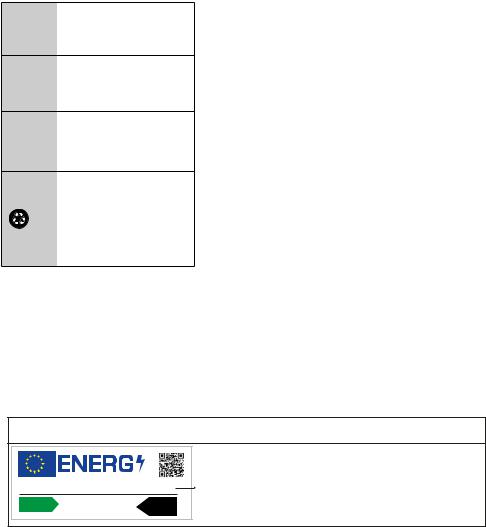
Please read this manual before using the product!
Dear Valued Customer,
We wish you to get the best results from your product that has been manufactured meticulously at modern plants and tested with detailed quality control checks.
For this reason, we recommend that you read this user manual thoroughly before starting the product. If you hand over the product to someone else, please remember to give the user manual as well.
This manual will help you use your appliance in a fast and safe way.
•Please read this user manual carefully before installing and using the product.
•Always follow the applicable safety instructions.
•Keep the user manual in an easily accessible place for further use.
•Please read all the other documents provided with the product.
Please keep in mind that this manual may apply to several product models. This manual expressly indicates the differences between various models.
C |
Important information and |
|
useful hints. |
||
|
||
A |
Risk of injury and property |
|
damage. |
||
|
||
B |
Risk of electric shock. |
Packaging materials of this product has been
manufactured from recyclable materials in accordance with the National Environment Regulations.
C INFORMATION |
|
|
|
|
|
The model information as stored in the product data |
base |
|
|
can be reached by entering following website and searching |
|
|
|
for your model identifier (*) found on energy label. |
|
SUPPLIER’S NAME |
MODEL IDENTIFIER |
(*) |
|
A |
A |
https://eprel.ec.europa.eu/ |
|
|
|
||
|
|
|
|

1 Important Instructions Regarding Safety and |
|
Environment |
9 |
1.1. General Safety . . . . . . . . . . . . . . . . . . . . . . . . . . 9 1.1.1 Hydrocarbon (HC) Warning . . . . . . . . . . . . . . . . 11 1.1.2 For Products with a Water Dispenser/Ice Machine11 1.2. Intended Use . . . . . . . . . . . . . . . . . . . . . . . . . . 12 1.3. Children's Safety . . . . . . . . . . . . . . . . . . . . . . . 12
1.4. Compliance with the WEEE Directive and Disposing the Waste Product: . . . . . . . . . . . . . . . . . . . . . 12
1.5. Compliance with the RoHS Directive:. . . . . . . . . 12 1.6. Packaging Information . . . . . . . . . . . . . . . . . . . 12
2 |
Your Refrigerator |
13 |
|
|
|
3 |
Installation |
14 |
3.1. Right place for installation. . . . . . . . . . . . . . . . . 14 3.2. Attaching the plastic wedges . . . . . . . . . . . . . . 14 3.3. Adjusting the stands . . . . . . . . . . . . . . . . . . . . . 14 3.4. Power connection. . . . . . . . . . . . . . . . . . . . . . . 14
4 Preparation |
15 |
4.1. What to do for energy saving . . . . . . . . . . . . . . 15 4.2. First Use . . . . . . . . . . . . . . . . . . . . . . . . . . . . . 15
5 Using the product |
16 |
5.1. Indicator panel . . . . . . . . . . . . . . . . . . . . . . . . . 16 5.2. Ice bucket . . . . . . . . . . . . . . . . . . . . . . . . . . . . 18 5.3. Eggholder . . . . . . . . . . . . . . . . . . . . . . . . . . . . 18 5.4. Fan . . . . . . . . . . . . . . . . . . . . . . . . . . . . . . . . . 18 5.5. Vegetable bin . . . . . . . . . . . . . . . . . . . . . . . . . 18 5.6. Zero degree compartment . . . . . . . . . . . . . . . . 18 5.7. Using the second crisper of the product; . . . . . . 19 5.8. Moving door rack . . . . . . . . . . . . . . . . . . . . . . . 20 5.9. Sliding storage box . . . . . . . . . . . . . . . . . . . . . 20 5.10.Moisture controlled vegetable bin . . . . . . . . . . . 20 5.11.Deodoriser Module . . . . . . . . . . . . . . . . . . . . . . 21 5.12.Automatic ice machine . . . . . . . . . . . . . . . . . . 21 5.13.Icematic and ice storage container . . . . . . . . . . 22 5.14.Using the water dispenser . . . . . . . . . . . . . . . . 22 5.15.Filling the water dispenser's tank . . . . . . . . . . . 23
5.16. Cleaning the water tank . . . . . . . . . . . . . . . . . 23 5.17.Drip tray. . . . . . . . . . . . . . . . . . . . . . . . . . . . . . 24 5.18.HerbBox/HerbFresh . . . . . . . . . . . . . . . . . . . . . 24 5.19.Freezing fresh food. . . . . . . . . . . . . . . . . . . . . . 25 5.20.Recommendations for storing frozen foods . . . . 25 5.21.Deep freezer details . . . . . . . . . . . . . . . . . . . . . 26 5.22.Placing the food . . . . . . . . . . . . . . . . . . . . . . . . 26 5.23.Door open alert . . . . . . . . . . . . . . . . . . . . . . . . 26 5.24.Changing the opening direction of the door . . . . 26 5.25.Interior light . . . . . . . . . . . . . . . . . . . . . . . . . . . 26 5.26.Blue light/HarvestFresh. . . . . . . . . . . . . . . . . . . 26 5.27.The dairy (cold storage) bin . . . . . . . . . . . . . . . 26
6 Care and Cleaning |
27 |
6.1. Avoiding Bad Odours . . . . . . . . . . . . . . . . . . . . 27 6.2. Protection of plastic surfaces . . . . . . . . . . . . . . 27 6.3. Cleaning the Inner Surface . . . . . . . . . . . . . . . . 27 6.4. Stainless Steel Outer Surfaces . . . . . . . . . . . . . 27
6 Care and Cleaning |
28 |
6.5. Cleaning Products with Glass Doors . . . . . . . . . 28
7 Troubleshooting |
29 |
|
|
|
8 /36 EN |
Refrigerator / User Guide |
|
|
|
|
|
|
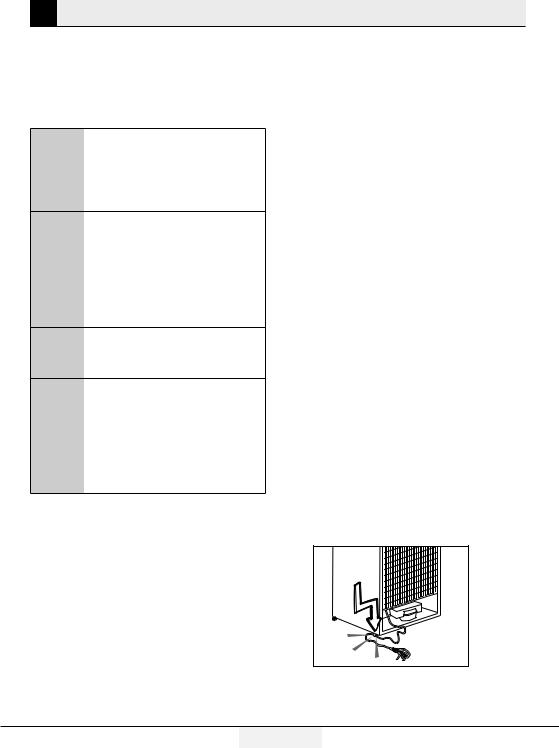
1 Important Instructions Regarding Safety and Environment
This chapter contains safety information that will help you avoid the risk personal injury or property damage. Failure to follow these instructions shall render any product warranty void.
Intended use
WARNING:
Keep ventilation openings, in
Athe appliance enclosure or in the built-instructure, clear of obstruction.
WARNING:
Do not use mechanical
devices or other means to
Aaccelerate the defrosting process, other than those recommended by the manufacturer.
WARNING:
ADo not damage the refrigerant circuit.
WARNING:
Do not use electrical appliances inside the food
Astorage compartments of the appliance, unless they are of the type recommended by the manufacturer.
This appliance is intended to be used in household and similar applications such as
–staff kitchen areas in shops, offices and other working environments;
–farm houses and by clients in hotels, motels and other residential type environments;
–bed and breakfast type environments;
–catering and similar non-retail applications.
1.1. General Safety
•Persons with physical, sensory or mental disabilities; persons who lack experience and information and
children should not approach, enter or play with the product.
•Failure to follow the instructions and uncontrolled use of the product lead to dangerous results!
•Unplug the product if you encounter a failure during use.
•If the product malfunctions, it must not be operated until repaired by the authorised service provider. Risk of electric shock!
•Plug the product into a grounded socket protected by a fuse that corresponds to the value on its nameplate. Have a qualified electrician ground the product. Our company cannot be held responsible for damages resulting from the failure to use the product with a grounded socket pursuant to local regulations.
•Unplug the product when not in use.
•Never wash the product by spreading or pouring water onto it! Risk of electric shock!
•Never touch the plug with wet hands!
•Never unplug the product by pulling the cable. Always pull the plug by holding the socket.
Refrigerator / User Guide |
9/36 EN |
|

Safety and environment instructions
• Do not plug the refrigerator if the wall |
channels of the evaporator, pipe |
socket is loose. |
extensions or surface coatings are |
• Never connect your refrigerator to |
punctured causes skin irritations and |
energy saving devices. Such systems |
eye injuries. |
are harmful to your product. |
• Do not cover or block the ventilation |
• Unplug the product during |
holes in your refrigerator with any |
installation, care, cleaning and |
object. |
repairing procedures. |
• Place the beverage with higher proofs |
• Always have the Authorised Service |
tightly closed and vertically. |
Provider install the product and |
• Do not use gaseous sprays near the |
establish its electrical connections. |
product since there is the risk or fire |
The manufacturer cannot be held |
or explosion! |
responsible for damages caused |
• Flammable items or products that |
by procedures performed by |
contain flammable gases (e.g. spray) |
unauthorised persons. |
as well as explosive materials should |
• Do not eat cone ice cream or ice |
never be kept in the appliance. |
cubes immediately after you take |
• Do not place vessels filled with liquid |
them out of the freezer compartment! |
onto the product. Splashing water on |
This may cause frostbite in your |
an electrical part may cause electric |
mouth! |
chock or the risk of fire. |
• Do not touch frozen food with wet |
• Do not store items that need precise |
hands! They may stick to your hand! |
temperature adjustment (such as |
• Do not put bottled or canned |
vaccines, heat-sensitive medication, |
liquid beverages in the freezer |
science materials etc.) in the |
compartment. They may burst! |
refrigerator. |
• Never use steam or steam cleaners |
• If you are not going to use the product |
to clean or defrost the refrigerator. |
for a long time, unplug it and remove |
Steam gets into contact with the live |
the food in it. |
parts in your refrigerator, causing |
• If there is a blue light on the |
short circuit or electric shock! |
refrigerator, do not look at this light |
• Do not use mechanical devices |
with optical tools. |
or other means to accelerate the |
• Exposing the product to rain, snow, |
defrosting process other than those |
sun or wind is dangerous in terms of |
recommended by the manufacturer. |
electrical safety. |
• Never use the parts in your |
• In products with mechanical control |
refrigerator such as the door and |
(thermostat), wait for 5 minutes |
drawer as a means of support or |
to plug in the product again after |
step. This may cause the product to |
unplugging. |
tip over or damage the parts of it. |
• Do not overload the refrigerator. |
• Do not damage the parts where the |
Objects in the refrigerator may fall |
refrigerant is circulating with drilling |
down when the door is opened, |
or cutting tools. The refrigerant |
causing injury or damage. Similar |
that might blow out when the gas |
|
10 /35EN |
Refrigerator / User Guide |

Safety and environment instructions
problems may arise if any object is |
|
|
|
WARNING: |
|
placed onto the product. |
A |
|
• If the product has a door handle, do |
Never throw the product into fire |
|
not pull the handle when re-locating |
|
for disposal. |
the product. The handle might be loose.
• Be careful not to jam your hand or |
1.1.2 For Products with a Water |
|||
any other body part in the moving |
Dispenser/Ice Machine |
|||
parts of the refrigerator. |
• Pressure for cold water inlet shall |
|||
• Do not put your hand or any other |
|
be maximum 90 psi (620 kPa). If |
||
foreign materials into the ice |
|
your water pressure exceeds 80 psi |
||
machine while it is operating. |
|
(550 kPa), use a pressure limiting |
||
1.1.1 Hydrocarbon (HC) Warning |
|
valve in your mains system. If you |
||
|
do not know how to check your |
|||
• If your product's cooling system |
|
|||
contains R600a: |
|
water pressure, ask for the help of a |
||
This gas is flammable. Therefore, pay |
|
professional plumber. |
||
attention not to damage the cooling |
• If there is a risk of water impact |
|||
system or the piping during use and |
|
in your installation, always use a |
||
transportation. If damaged, keep |
|
water impact protection equipment |
||
the product away from potential fire |
|
in that installation. Please consult |
||
sources that may cause it to catch |
|
professional plumbers if you are not |
||
fire and ventilate the room where the |
|
sure if there is water impact in your |
||
product is placed. |
|
installation. |
||
|
|
• Do not make installation on the hot |
||
|
|
|
water inlet. |
|
|
If the product is damaged and |
• Use drinking water only. |
||
|
if you see gas leak, please |
• Take the necessary measures |
||
C |
keep away from the gas. It may |
|
against the freezing risk of the |
|
cause frostbite when it gets into |
|
hoses. The water temperature |
||
|
contact with the skin. |
|
operating range must be 0.6°C |
|
|
(including R134) |
|
(33°F) minimum and 38°C (100°F) |
|
C |
Ignore this warning if the cooling |
|
maximum. |
|
system of your product contains |
|
|
|
|
|
|
WARNING: |
||
|
R134a. |
|
|
|
|
|
A |
Never connect the product |
|
|
Type of gas used in the product |
|
to a cold water mains with a |
|
C |
is stated on the type plate which |
|
|
pressure of 550 kPa (80 psi) |
|
is on the left wall inside the |
|
|
or above. |
|
refrigerator. |
|
|
|
Refrigerator / User Guide |
11/35EN |
|
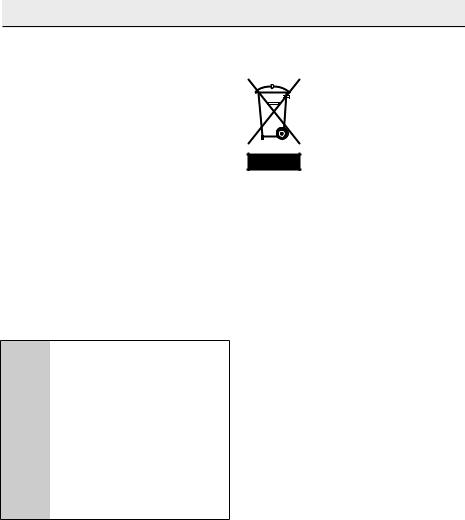
Safety and environment instructions
1.2. Intended Use
•This product has been designed for domestic use. It is not suitable for commercial use and it must not be used out of its intended use.
•It must be used only for storing food.
•The manufacturer will not take any responsibility for damages resulting from improper use or transport.
•Original spare parts will be available for 10 years after the purchase date of the product.
1.3. Children's Safety
•If there is a lock on the door of the product, the key should be kept out of the reach of children.
•Do not let children play with the product.
DANGER:
Before disposing your old refrigerator or freezer:
•Children may get locked inside.
A • Remove the doors.
•Leave the shelves to prevent children from getting inside the product easily.
1.4. Compliance with the WEEE Directive and Disposing the Waste Product:
This product conforms to the EU
WEE Directive (2012/19 EU). This product bears a classification symbol for waste electrical and electronic
equipment (WEEE). This product has been manufactured from high quality parts and materials which can be
reused and are suitable for recycling. Therefore, do not dispose the product with normal domestic waste or other waste at the end of its service life. Take it to a collection centre for recycling electrical and electronic equipment. Please consult local authorities to learn about the locations of such collection centres.
1.5.Compliance with the RoHS Directive:
The unit you have purchased conforms to the EU RoHS Directive (2011/65/EU). It does not contain harmful or prohibited materials specified in the Directive.
1.6.Packaging Information
•Packaging materials of the product have been manufactured from recyclable materials in accordance with our National Environment Regulations. Do not dispose the packaging materials with normal domestic waste or other types of waste. Take these materials to a recycling point designated by local authorities.
|
DANGER: |
|
Risk of Fire or Explosion: |
|
• This product uses flammable |
|
refrigerant. |
|
• Do not use mechanical devices to |
|
defrost the refrigerator. |
|
• Do not use chemicals for cleaning. |
A |
• Do not pierce the refrigerant pipe. |
• If the refrigerant pipe is pierced, it |
|
|
must be repaired only by licensed |
|
service personnel. |
|
• Please consult the repair/user |
|
manual before cleaning the product. |
|
All safety instructions must be |
|
followed. |
|
• Dispose the product according to |
|
federal or local regulations. |
|
12 /35EN |
Refrigerator / User Guide |
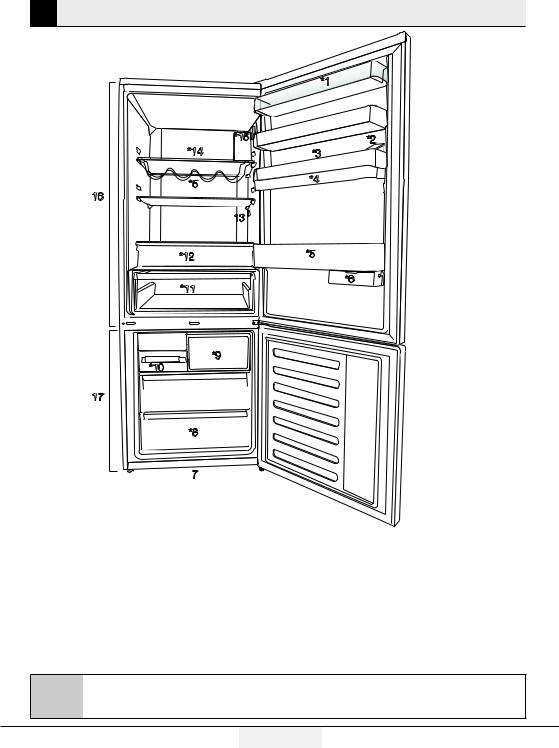
2 Your Refrigerator
|
*1 |
*15 |
*2 |
*14 |
*3 |
*5 |
*4 |
|
|
16 |
|
13 |
|
*12 |
*5 |
*11 |
*6 |
|
 *9 *10
*9 *10
17
*8
7
1. |
Cooler compartment door shelf |
11. |
Vegetable bin |
2. |
Water dispenser filling tank |
12. |
Dairy (cold storage) bin |
3. |
Egg section |
13. |
Interior light |
4. |
Water dispenser reservoir |
14. |
Cooler compartment glass shelf |
5. |
Bottle shelf |
15. |
Temperature adjustment button |
6. |
Sliding storage box |
16. |
Cooler compartment |
7. |
Adjustable legs |
17. |
Freezer compartment |
8. |
Deep freezer compartment |
May not be available in all models |
|
9. |
Quick freeze compartment |
||
10. |
Ice cube tray & Ice bank |
|
|
*optional: Pictures given in this manual are given as example figures and they may not be exactly C the same as your product. If your product does not comprise the relevant parts, the information
pertains to other models.
Refrigerator / User Guide |
13/36 EN |
|
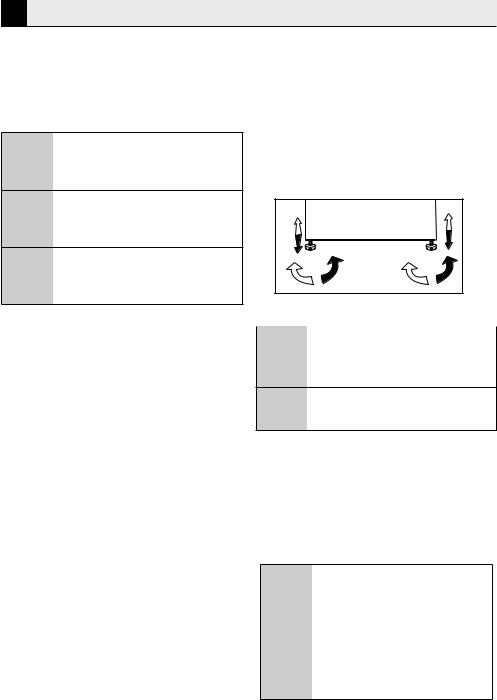
3 Installation
3.1. Right place for installation
Contact the Authorized Service for the product's installation. To ready the product for installation, see the information in the user guide and make sure the electric and water utilities are as required. If not, call an electrician and plumber to arrange the utilities as necessary.
WARNING: The manufacturer assumes B no responsibility for any damage caused
by the work carried out by unauthorized persons.
WARNING: The product’s power cable B must be unplugged during installation.
Failure to do so may result in death or serious injuries!
WARNING: If the door span is too narrow A for the product to pass, remove the door
and turn the product sideways; if this does not work, contact the authorized service.
•Place the product on a flat surface to avoid vibration.
•Place the product at least 30 cm away from the heater, stove and similar sources of heat and at least 5 cm away from electric ovens.
•Do not expose the product to direct sunlight or keep in damp environments.
•The product requires adequate air circulation to function efficiently.
•If the product will be placed in an alcove, remember to leave at least 5 cm distance between the product and the ceiling and the walls.
•Do not install the product in environments with temperatures below -5°C.
•Your product requires adequate air circulation to function efficiently. If the product will be placed in an alcove, remember to leave at least 5 cm clearance between the product and the ceiling, rear wall and the side walls.
•If the product will be placed in an alcove, remember to leave at least 5 cm clearance between the product and the ceiling, rear wall and the side walls. Check if the rear wall clearance protection
component is present at its location (if provided with the product). If the component is not available, or
if it is lost or fallen, position the product so that at least 5 cm clearance shall be left between the rear surface of the product and the wall of the room. The clearance at the rear is important for efficient operation of the product.
3.2. Attaching the plastic wedges
Use the plastic wedges in the provided with the product to provide sufficient space for air circulation between the product and the wall.
1.To attach the wedges, remove the screws on the product and use the screws provided with the wedges.
2.Attach 2 plastic wedges on the ventilation cover as shown in the figure.
3.3. Adjusting the stands
If the product is not in balanced position, adjust the front adjustable stands by rotating right or left.
3.4. |
Power connection |
|
|
A |
WARNING: Do not use extension or multi |
|
sockets in power connection. |
B |
WARNING: Damaged power cable must |
|
be replaced by Authorized Service. |
When placing two coolers in adjacent C position, leave at least 4 cm distance
between the two units.
•Our firm will not assume responsibility for any damages due to usage without earthing and power connection in compliance with national regulations.
•The power cable plug must be easily accessible after installation.
•Do not use multi-group plug with or without extension cable between the wall socket and the refrigerator.
Hot Surface Warning!
Side walls of your product is equipped with refrigerant pipes to improve the cooling system. Refrigerant with high
C temperatures may flow through these areas, resulting in hot surfaces on the side walls. This is normal and does not need any servicing. Please pay attention while touching these areas.
|
14 /36 EN |
Refrigerator / User Guide |
|
|
|
|
|
|
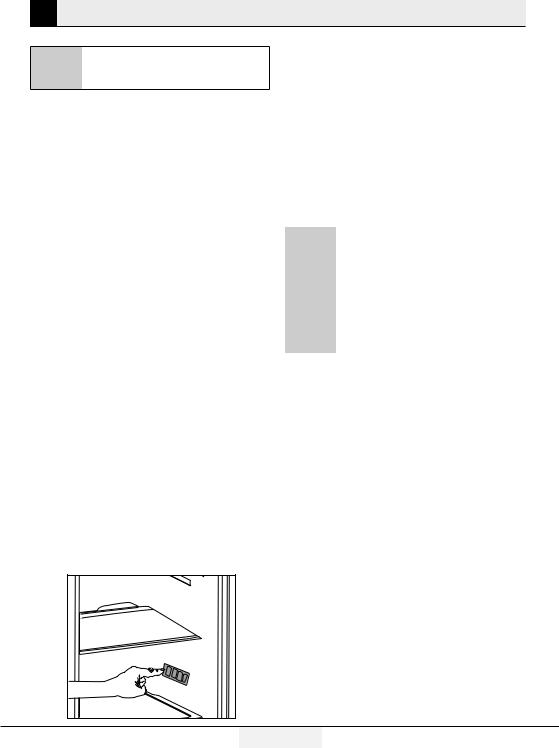
4 Preparation
4.1. What to do for energy saving
Connecting the product to electronic A energy-saving systems is harmful, as it
may damage the product.
•For a freestanding appliance; ‘this refrigerating appliance is not intended to be used as a built-in appliance’ .
•Do not keep the refrigerator doors open for long periods.
•Do not place hot food or beverages into the refrigerator.
•Do not overfill the refrigerator; blocking the internal air flow will reduce cooling capacity.
•In order to store the maximum amount of food into the cooler compartment of your refrigerator, you should take out the upper drawers and place it onto the glass rack. The declared energy consumption of your refrigerator was determined by taking out the cooler, ice tray and upper drawers in a way that will enable maximum storage. Using the below drawer when storing is strongly recommended. Energy saving function should be activated for best energy consumption.
•You should not block the airflow by putting food in front of the cooler fan. A space of minimum 3cm must be left in front of the protective fan wire when placing food.
•Depending on the product’s features; defrosting frozen foods in the cooler compartment will ensure energy saving and preserve food quality.
•Food should be stored using the drawers in the cooler compartment in order to ensure energy saving and protect food in better conditions.
•Food packages should not be in direct contact with the heat sensor located in the cooler compartment. If they are in contact with the sensor, energy consumption of the appliance might increase.
•Make sure the foods are not in contact with the cooler compartment temperature sensor described below.
•In case of multiple options are present glass shelves must be placed so that the air outlets at the backwall are not blocked, prefably air outlets are remaining below the glass shelf. This combination may help impoving air distribution and energy efficiency.
4.2. First Use
Before using your refrigerator, make sure the necessary preparations are made in line with the instructions in “Safety and environment instructions” and “Installation” sections.
•Keep the product running with no food inside for 6 and do not open the door, unless absolutely necessary.
C |
A sound will be heard when the |
|
compressor is engaged. It is normal to |
|
hear sound even when the compressor is |
|
inactive, due to the compressed liquids and |
|
gasses in the cooling system. |
C |
Front edges of the product might heat |
|
up. This is normal. These areas are |
|
designed to warm up in order to prevent |
|
condensation. |
|
|
C |
In some models indicator panel turns off |
|
automatically 5 minutes after the door |
|
closes. It will be reactivated when the door |
|
is open or any button is pressed. |
• Since hot and humid air will not directly penetrate into your product when the doors are not opened, your product will optimize itself in conditions sufficient to protect your food. Functions and components such as compressor, fan, heater, defrost, lighting, display and so on will operate according to the needs to consume minimum energy under these circumstances.
Refrigerator / User Guide |
15/36 EN |
|

5 Using the product
5.1. Indicator panel
Indicator panel allows you to set the temperature and control the other functions related to the product without opening the door of the product. Just press the inscriptions on relevant buttons for function settings.
1 2
11 

10 |
9 |
8 |
7 |
6 |
5 |
4 |
3 |
1. Power Failure / High temperature / Error status indicator
This indicator (  ) illuminates in case of power failure, high temperature and error warnings.
) illuminates in case of power failure, high temperature and error warnings.
When the temperature of the freezer compartment is heated up to a critical level for the frozen food, the
maximum value reached by the freezer compartment temperature flashes on the digital indicator.
Check the food in the freezer compartment.
This is not a malfunction. The warning may be deleted by pressing any button or on high temperature alarm off button. (Cancelling by pressing any button is not applicable for every model.)
This indicator (  ) illuminated when a sensor failure occurs, too. When this indicator is illuminated, “E” and figures such as “1,2,3...” are displayed alternatively on the temperature indicator. These figures on the indicator inform the service personnel about the error.
) illuminated when a sensor failure occurs, too. When this indicator is illuminated, “E” and figures such as “1,2,3...” are displayed alternatively on the temperature indicator. These figures on the indicator inform the service personnel about the error.
2. Energy saving function (display off)
If the product doors are kept closed for a long time energy saving function is automatically activated and energy saving symbol is illuminated. ( )
)
When energy saving function is activated, all symbols on the display other than energy saving symbol will turn
off. When the Energy Saving function is activated, if any button is pressed or the door is opened, energy saving function will be canceled and the symbols on display will return to normal.
Energy saving function is activated during delivery from factory and cannot be canceled.
3.Quick fridge function
The button has two functions. To activate or deactivate the quick cool function press it briefly. Quick Cool indicator will turn off and the product will return to its normal settings. (  )
)
C |
Use quick cooling function when you |
|
want to quickly cool the food placed |
|
in the fridge compartment. If you want |
|
to cool large amounts of fresh food, |
|
activate this function before putting the |
|
food into the product. |
C |
If you do not cancel it, quick cooling |
|
will cancel itself automatically after 1 |
|
hours or when the fridge compartment |
|
reaches to the required temperature. |
|
|
May not be available in all models
C
*Optional: The figures in this user guide are intended as drafts and may not perfectly match your product. If your product does not comprise the relevant parts, the information pertains to other models.
16 /36 EN |
Refrigerator / User Guide |
|
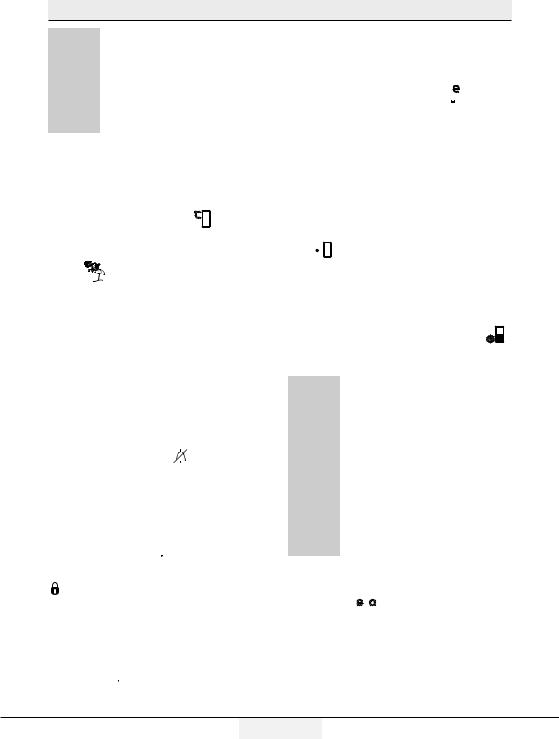
Using the product
C |
If you press the quick cooling button |
|
repeatedly with short intervals, the |
|
electronic circuit protection will be |
|
activated and the compressor will not |
|
start up immediately. |
C |
This function is not recalled when |
|
power restores after a power failure. |
|
|
4. Fridge compartment temperature setting button
Press this button to set the temperature of the fridge compartment to 8,7,6, 5,4,3, 2 ,1 ,8... respectively. Press this button to set the fridge compartment temperature to the desired value. (  ) )
) )
5.Vacation Function
In order to activate vacation function, press the this button ( 



 ) for 3 seconds, and the vacation mode indicator ( ) will be activated. When the vacation function is activated, “- -” is displayed on the fridge compartment temperature indicator and no active cooling is performed on the fridge compartment.
) for 3 seconds, and the vacation mode indicator ( ) will be activated. When the vacation function is activated, “- -” is displayed on the fridge compartment temperature indicator and no active cooling is performed on the fridge compartment.
It is not suitable to keep the food in the fridge compartment when this function is activated. Other compartments shall be continued to be cooled as per their set temperature.
To cancel this function press Vacation function button again.
6. Termination of the High Temperature Warning:
In case of power failure/high temperature warning, you may delete the warning ( ) by pressing any button on the indicator or high temperature alarm off button for 1 second after checking the food inside the freezer compartment.
Note: Cancelling by pressing any button is not applicable for every model.
7. Key lock
Press key lock button ( 
 ) simultaneously for 3 seconds. Key lock symbol
) simultaneously for 3 seconds. Key lock symbol
) will light up and key lock mode will be activated. Buttons will not function if the Key lock mode is active. Press key lock button simultaneously for 3 seconds again. Key lock symbol will turn off and the key lock mode will be exited.
Press the key lock button if you want to prevent changing of the temperature setting of the refrigerator ( 
 ).
).
8. Eco fuzzy
Press and hold eco fuzzy button for 1 seconds to activate eco fuzzy function. Refrigerator will start operating in the most economic mode at least 6 hours later and the economic usage indicator will turn on when the function is active (  ). Press and hold eco fuzzy function button for 3 seconds to deactivate eco fuzzy function.
). Press and hold eco fuzzy function button for 3 seconds to deactivate eco fuzzy function.
This indicator is illuminated after 6 hours when eco fuzzy is activated.
9. Freezer compartment temperature setting button
Press this button to set the temperature of the freezer compartment to -18,-19,-20,-21, -22, -23,- 24, -18... respectively. Press this button to set the freezer compartment temperature to the desired value.( )
)
10. Quick freeze function button/ icematic on-off button
Press this button to activate or deactivate the quick freezing function. When you activate the function, the freezer compartment will be cooled to a temperature lower than the set value. (  ) To turn on and off the icematic press and hold it for 3 seconds.
) To turn on and off the icematic press and hold it for 3 seconds.
C |
Use the quick freeze function when you |
|
want to quickly freeze the food placed |
|
in fridge compartment. If you want to |
|
freeze large amounts of fresh food, |
|
activate this function before putting the |
|
food into the product. |
C |
If you do not cancel it, Quick Freeze |
|
will cancel itself automatically after 24 |
|
hours or when the fridge compartment |
|
reaches to the required temperature. |
|
|
C |
This function is not recalled when |
|
power restores after a power failure. |
11. Economic usage indicator
Indicates that the product is running in energyefficient mode. (  )This indicator will be active if the Freezer Compartment temperature is set to -18 or the energy efficient cooling is being performed due to Eco-Extra function.
)This indicator will be active if the Freezer Compartment temperature is set to -18 or the energy efficient cooling is being performed due to Eco-Extra function.
C |
Economic usage indicator is turned |
|
off when quick cooling or quick freeze |
|
functions are selected. |
Refrigerator / User Guide |
17/35EN |
|
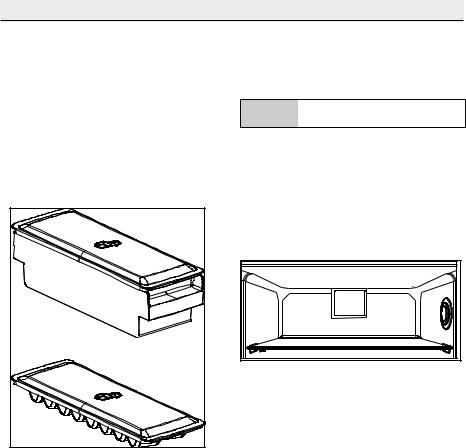
Using the product
5.2. Ice bucket |
5.3. |
Eggholder |
|
*optional |
You can put the eggholder on the door or body rack of |
||
• Take the ice bucket from the freezer |
your choice. If you decide to put it on the body rack, it is |
||
compartment. |
recommended to prefer the shelves below as they are |
||
• Fill the ice bucket with water. |
colder. |
|
|
• Place the ice bucket into the freezer |
A |
Do not put the eggholder into the |
|
compartment. |
|||
freezer compartment. |
|||
• The ice will be ready after approximately |
|
||
|
|
||
two hours. Take the ice bucket from |
5.4. |
Fan |
|
the freezer compartment and bend in |
|||
sightly over the holder that you are going |
Fan was designed to distribute circulate the cold air |
||
to serve. Ice will easily pour into |
inside your refrigerator homogeneously. Operating |
||
the serving holder. |
time of the fan might vary depending the features of |
||
|
your product. |
||
|
While in some products fan only operates with |
||
|
compressor, in others control system determines the |
||
|
operating time based on the need for cooling. |
||
5.5. Vegetable bin
*optional
Product’s vegetable bin is designed to keep vegetables fresh by preserving humidity. For this purpose, the overall cold air circulation is intensified in the vegetable bin.
5.6. Zero degree compartment
*optional
Use this compartment to keep delicatessen at lower temperatures or meat products for immediate consumption.
Zero degree compartment is the coolest place where foods such as dairy products, meat, fish and chicken can be stored in ideal storage conditions. Vegetables and/or fruits should not be stored in this compartment.
|
18 /35EN |
Refrigerator / User Guide |
|
|
|
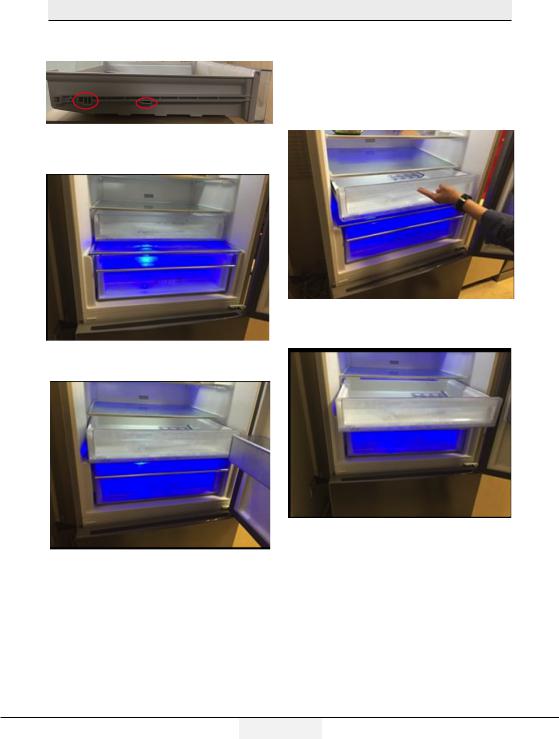
Using the product
5.7. Using the second crisper of the product;
Figure 1.
As shown in the figure, there are 2 stoppers in the second crisper of K70560 model product.
Figure 2.
The second crisper looks like Figure 2 when closed.
Figure 3.
With the door is open 90°, pull the second crisper up to the first stopper as shown in Figure 3.
In the case that the drawer is more open, first of all, open the door by at least 135° degrees. After
that, as shown in Figure 4, lift the second crisper for about 5 mm so that it is freed from the first stopper.
Figure 4.
After lifting, pull the second drawer up to the second stopper as shown in Figure 5.
Figure 5.
Refrigerator / User Guide |
19/35EN |
|
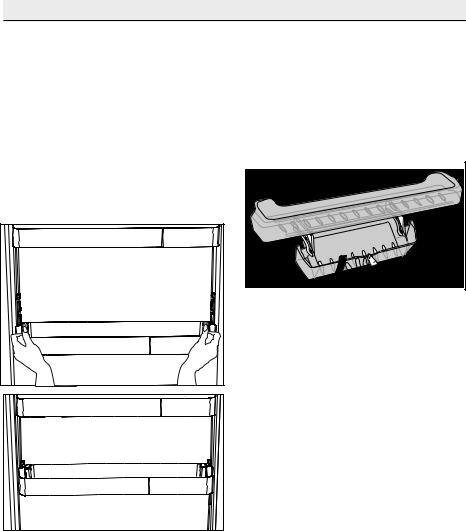
Using the product
5.8. Moving door rack
*optional
Moving door rack can be fixed in 3 different positions.
In order to move the rack, push the buttons on the side evenly. Rack will be movable.
Move the rack up or down.
When the rack is in the position that you want, release the buttons. Rack will be fixed again
in the position where you have released the buttons.
5.9. Sliding storage box
*optional
This accessory has been designed to increase the usage volume of the door racks.
Thanks to its ability to move sideways, it enables you to easily place long bottle, jar or boxes that you put in the bottle rack below.
5.10. Moisture controlled vegetable bin
*optional
With moisture control feature, moisture rates of vegetables and fruits are kept under control and ensures a longer freshness period for foods.
It is recommended to store leafed vegetables such as lettuce and spinach and similar vegetables prone to moisture loss not on their roots but in horizontal position into the vegetable bin as much as possible.
When placing the vegetables, place heavy and hard vegetables at the bottom and light and soft ones on the top, taking into account the specific weights of vegetables.
Do not leave vegetables in the vegetable bin in plastic bags. Leaving them in plastic bags causes vegetables to rot in a short time. In situations where contact with other vegetables is not preferred,
use packaging materials such as paper that has a certain porosity in terms of hygiene.
Do not put fruits that have a high ethylene gas production such as pear, apricot, peach and particularly apple in the same vegetable bin with other vegetables and fruits. The ethylene gas coming out of these fruits might cause other vegetables and fruits to mature faster and rot in a shorter period of time.
|
20 /35EN |
Refrigerator / User Guide |
|
|
|
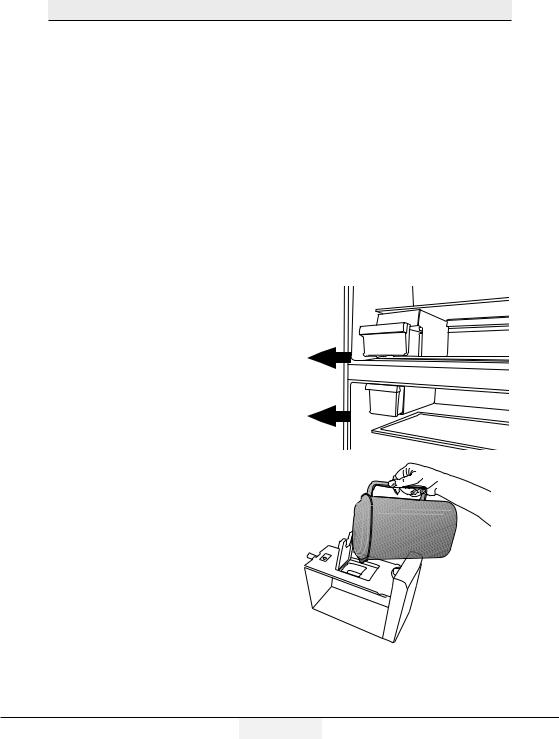
Using the product
5.11. Deodoriser Module
(FreshGuard) *optional
The deodoriser module quickly eliminates the bad smells in your refrigerator before they permeate the surfaces. Thanks to this module, which is placed on the ceiling of the fresh food compartment, the bad odours dissolve while the air is actively being passed on the odour filter, then the air that has been cleaned by the filter is re-emitted to the fresh food compartment. This way, the unwanted odours that may emerge during the storage of foods in the refrigerator are eliminated before they permeate the surfaces.
This is achieved thanks to the fan, LED and the odour filter integrated into the module. In daily use, the deodoriser module will turn on automatically on a periodic basis. To maintain efficient performance, it is recommended to have the filter in the deodoriser module by the authorised service provider every 5 years. Due to the fan integrated into the module, the noise you will hear during operation is normal. If you open the door of the fresh food compartment while the module is active, the fan will pause temporarily and resume where it has left off after some time
the door is closed again. In case of power failure, the deodoriser module will resume where it has left off in the total operation duration once the power is back.
Info: It is recommended to store aromatic foods (such as cheese, olives and delicatessen foods) in their packaging and sealed to avoid bad odours that may result when smells of various foods get mixed. Besides, it is recommended to take spoiled foods out of the refrigerator quickly to prevent the other foods from getting spoiled and avoid bad odours.
5.12. Automatic ice machine
*optional
Automatic ice machine enables you to easily make ice in your refrigerator. In order to obtain ice from the ice machine, take out the water tank in the cooler compartment, fill it with water and fix it back.
First ice will be ready in about 2 hours in the ice machine drawer in the cooler compartment.
After placing the full water tank, you can obtain about 60-70 cubes of ice until it is fully empty.
If the water in the tank has waited for 2-3 weeks, it should be changed.
|
C |
In products with automatic ice |
|
||||||||
|
|
machine, you might hear a sound |
|
||||||||
|
|
when pouring the ice. This sound is |
|
||||||||
|
|
normal and is not a sign of failure. |
|
||||||||
|
|
|
|
|
|
|
|
|
|
|
|
|
|
|
|
|
|
|
|
|
|
|
|
|
|
|
|
|
|
|
|
|
|
|
|
|
|
|
|
|
|
|
|
|
|
|
|
|
|
|
|
|
|
|
|
|
|
|
|
|
|
|
|
|
|
|
|
|
|
|
|
|
|
|
|
|
|
|
|
|
|
|
|
|
|
|
|
|
|
|
|
|
|
|
|
|
|
|
|
|
|
|
|
|
|
|
|
|
|
|
|
|
|
|
|
|
|
|
|
Refrigerator / User Guide |
21/35EN |
|
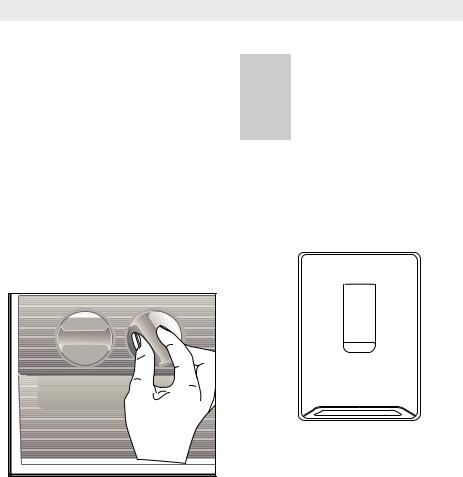
Using the product
|
|
|
|
|
|
|
|
|
|
||
5.13. Icematic and ice storage container |
5.14. Using the water dispenser |
||||||||||
*optional |
*optional |
|
|
|
|
|
|
||||
Using the Icematic |
|
|
|
|
|
|
|
|
|||
C |
It is normal for the first few glasses of |
||||||||||
Fill the Icematic with water and place it into its seat. |
|
|
water taken from the dispenser to be |
||||||||
Your ice will be ready approximately in two hours. Do |
|
|
warm. |
||||||||
not remove the Icematic from its seating to take ice. |
C |
If the water dispenser is not used for a |
|||||||||
Turn the knobs on the ice reservoirs clockwise by |
|||||||||||
|
|
long period of time, dispose of first few |
|||||||||
90 degrees. |
|
|
glasses of water to obtain fresh water. |
||||||||
Ice cubes in the reservoirs will fall down into the ice |
1. Push in the lever of the water dispenser with your |
||||||||||
storage container below. |
|||||||||||
glass. If you are using a soft plastic cup, pushing |
|||||||||||
You may take out the ice storage container and |
|||||||||||
the lever with your hand will be easier. |
|||||||||||
serve the ice cubes. |
|||||||||||
2. After filling the cup up to the level you want, rele- |
|||||||||||
If you wish, you may keep the ice cubes in the ice |
|||||||||||
ase the lever. |
|||||||||||
storage container. |
|||||||||||
|
|
|
|
|
|
|
|
||||
Ice storage container |
|
|
|
|
|
|
|
|
|||
Ice storage container is only intended for |
|
|
|
|
|
|
|
|
|||
accumulating the ice cubes. Do not put water in it. |
|
|
|
|
|
|
|
|
|||
Otherwise, it will break. |
|
|
|
|
|
|
|
|
|||
|
|
|
|
|
|
|
|
|
|
|
|
|
|
|
|
|
|
|
|
|
|
|
|
|
|
|
|
|
|
|
|
|
|
|
|
|
|
|
|
|
|
|
|
|
|
|
|
|
|
|
|
|
|
|
|
|
|
|
|
|
|
|
|
|
|
|
|
|
|
|
|
|
|
|
|
|
|
|
|
|
|
|
|
|
|
|
|
|
|
|
|
|
|
|
|
|
|
|
|
|
|
|
|
|
|
|
|
|
|
|
|
|
|
|
|
|
|
|
|
C |
Please note, how much water flows |
|
from the dispenser depends on how far |
|
you depress the lever. As the level of |
|
water in your cup / glass rises, gently |
|
reduce the amount of pressure on the |
|
lever to avoid overflow. If you slightly |
|
press the arm, the water will drip; this |
|
is quite normal and not a failure. |
|
22 /35EN |
Refrigerator / User Guide |
|
|
|
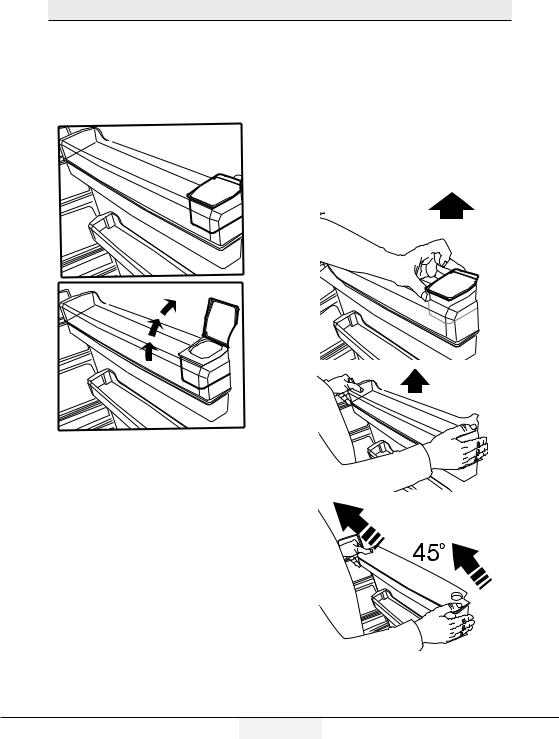
Using the product
5.15. Filling the water dispenser's tank
Water tank filling reservoir is located inside the door rack.
1.Open the cover of the tank.
2.Fill the tank with fresh drinking water.
3.Close the cover.
C |
Do not fill the water tank with any |
|
|
other liquid except for water such as |
|
|
fruit juices, carbonated beverages or |
|
|
alcoholic drinks which are not suitable |
|
|
to use in the water dispenser. Water |
|
|
dispenser will be irreparably damaged |
|
|
if these kinds of liquids are used. |
|
|
Warranty does not cover such usages. |
|
|
Some chemical substances and |
|
|
additives contained in these kinds of |
|
|
drinks/liquids may damage the water |
|
|
tank. |
|
|
|
|
C |
Use clean drinking water only. |
|
|
|
|
|
|
|
C |
Capacity of the water tank is 3 litres; |
|
|
do not overfill. |
|
5.16. Cleaning the water tank
1.Remove the water filling reservoir inside the door rack.
2.Remove the door rack by holding from both sides.
3.Grab the water tank from both sides and remove it with an angle of 45°C.
4.Remove the cover of the water tank and clean the tank.
C |
Components of the water tank and |
|||||||||
|
|
water dispenser should not be washed |
||||||||
|
|
in dishwasher. |
||||||||
|
|
|
|
|
|
|
|
|
|
|
|
|
|
|
|
|
|
|
|
|
|
|
|
|
|
|
|
|
|
|
|
|
|
|
|
|
|
|
|
|
|
|
|
|
|
|
|
|
|
|
|
|
|
|
|
|
|
|
|
|
|
|
|
|
|
|
|
|
|
|
|
|
|
|
|
|
|
|
|
|
|
|
|
|
|
|
|
|
|
|
|
|
|
|
|
|
|
|
|
|
|
|
|
|
|
|
|
|
|
|
|
|
|
|
|
|
|
|
|
|
|
|
|
|
|
|
|
|
|
|
|
|
|
|
|
|
|
|
|
|
|
|
|
|
|
|
|
|
|
|
|
|
|
|
|
|
|
|
|
|
|
|
|
|
|
|
|
|
|
|
|
|
|
|
|
Refrigerator / User Guide |
23/35EN |
|
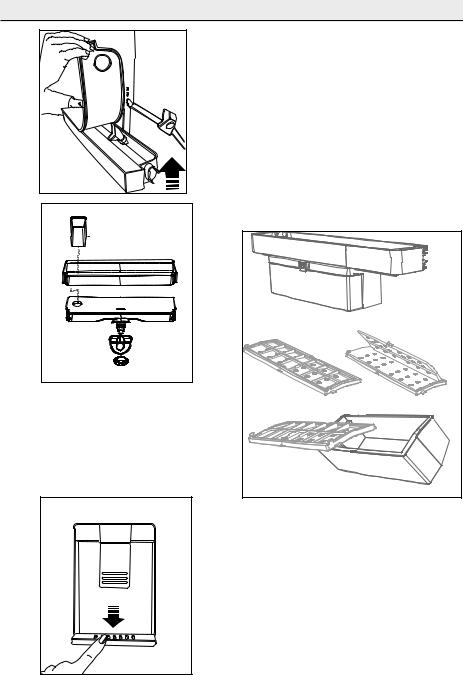
Using the product
5.18. HerbBox/HerbFresh
Remove the film container from HerbBox/ HerbFresh+
Take the film out of the bag and put it into the film container as shown in the image.
Seal the container again and replace it into HerbBox/ HerbFresh+ unit.
HerbBox-HerbFresh+ sections are especially ideal for storage of various herbs that are supposed to be kept in delicate conditions. You can store your unbagged herbs (parsley, dill, etc.) in this section horizontally and keep them fresh for a much longer period.
The film shall be replaced in every six months.
5.17. Drip tray
Water that dripped while using the water dispenser accumulates in the spillage tray.
Remove the plastic filter as shown in the figure.
With a clean and dry cloth, remove the water that has accumulated.
|
24 /35EN |
Refrigerator / User Guide |
|
|
|

Using the product
5.19. Freezing fresh food
•To preserve food quality, the food items placed in the freezer compartment must be frozen as quickly as possible, use the rapid freezing for this.
•Freezing the food items when fresh will extend the storage time in the freezer compartment.
•Pack the food items in air-tight packs and seal tightly.
•Make sure the food items are packed before putting in the freezer. Use freezer holders, tinfoil and damp-proof paper, plastic bag or similar packaging materials instead of traditional packaging paper.
C |
Ice in the freezing compartment thaws |
|
automatically. |
•Mark each food pack by writing the date on the package before freezing. This will allow you to determine the freshness of each pack every time the freezer is opened. Keep the earlier food items in the front to ensure they are used first.
•Frozen food items must be used immediately after defrosting and should not be frozen again.
•Do not free large quantities of food at once.
5.20. Recommendations for storing frozen foods
The compartment must be set to at least -18°C.
1.Place the food items in the freezer as quickly as possible to avoid defrosting.
2.Before freezing, check the “Expiry Date” on the package to make sure it is not expired.
3.Make sure the food’s packaging is not damaged.
Freezer |
Cooler |
|
|
Compartment |
Compartment |
Details |
|
Temperature |
Temperature |
||
|
|||
Setting |
Setting |
|
|
-18°C |
4°C |
This is the default, recommended setting. |
|
-20,-22 or |
4°C |
These settings are recommended for ambient temperatures exceeding |
|
-24°C |
30°C. |
||
|
|||
Quick Freeze |
4°C |
Use when you want to freeze your food in a short time. When the process |
|
ends, the product will regain its position. |
|||
|
|
||
|
|
|
|
-18°C or colder |
2°C |
Use these settings if you believe the cooler compartment is not cold enough |
|
due to ambient temperature or frequently opening the door. |
|||
|
|
||
|
|
|
Refrigerator / User Guide |
25/35EN |
|

Using the product
5.21. Deep freezer details
As per the IEC 62552 standards, the freezer must have the capacity to freeze 4,5 kg of food items at -18°C or lower temperatures in 24 hours for each 100 litres of freezer compartment volume.
Food items can only be preserved for extended periods at or below temperature of -18°C .
You can keep the foods fresh for months (in deep freezer at or below temperatures of 18°C ).
The food items to be frozen must not contact the already-frozen food inside to avoid partial defrosting. Boil the vegetables and filter the water to extend
the frozen storage time. Place the food in air-tight packages after filtering and place in the freezer. Bananas, tomatoes, lettuce, celery, boiled eggs, potatoes and similar food items should not be frozen. In case this food rots, only nutritional values and eating qualities will be negatively affected. A rotting threatening human health is not in question.
5.22. Placing the food
Freezer |
Various frozen goods including |
|
compartment |
meat, fish, ice cream, vegetables |
|
shelves |
etc. |
|
|
|
|
Cooler |
Food items inside pots, capped |
|
compartment |
plate and capped cases, eggs (in |
|
shelves |
capped case) |
|
Cooler |
|
|
compartment |
Small and packed food or beverages |
|
door shelves |
|
|
|
|
|
Vegetable bin |
Fruits and vegetables |
|
Fresh food |
Delicatessen (breakfast food, meat |
|
products to be consumed in short |
||
compartment |
||
notice) |
||
|
5.23. Door open alert
(Optional)
An audible alert will be heard if the product's door remains open for at least 1 minute. The audible alert will stop when the door is closed or any button on the display (if available) is pressed.
Door open alert is indicated to the user both audibly and visually. Interior lighting will turn of if the warning continues for 10 min.
5.24. Changing the opening direction of the door
You can change the direction of opening of your refrigerator depending on the location where you use it. When you need this, consult the closest Authorized Service.
The explanation above is a general statement. You should check the warning tag located inside the product package about the changeability of direction of the door.
5.25. Interior light
Interior light uses a LED type lamp. Contact the authorized service for any problems with this lamp. Lamp(s) used in this appliance cannot be used for house lighting. Intended use of this lamp is to help the user place food into the refrigerator / freezer safely and comfortably.
5.26. Blue light/HarvestFresh
*May not be available in all models
For the blue light,
Fruits and vegetables stored in the crispers that are illuminated with a blue light continue their
photosynthesis by means of the wavelength effect of blue light and thus preserve their vitamin content.
ForHarvestFresh,
Fruits and vegetables stored in crispers illuminated with the HarvestFresh technology preserve their vitamins for a longer time thanks to the blue, green, red lights and dark cycles, which simulate a day cycle.
If you open the door of the refrigerator during the dark period of the HarvestFresh technology, the refrigerator will automatically detect this and enable the bluegreen or red light to illuminate the crisper for your convenience. After you have closed the door of the refrigerator, the dark period will continue, representing the night time in a day cycle.
5.27.The dairy (cold storage) bin
Provides lower temperature within the refrigerator compartment. Use this bin to store delicatessen (salami, sausages, dairy products and etc. ) that requires lower storage temperature or meat, chicken or fish products for immediate consumption. Do not store fruits and vegetables inside this bin.
|
26 /35EN |
Refrigerator / User Guide |
|
|
|

6 Care and Cleaning
Service life of the product will extend and frequently encountered problems will decrease if the product is cleaned periodically.
B |
WARNING: Switch off the product |
|
|
|
before cleaning. |
|
|
B |
WARNING: It is recommended to |
|
clean the condenser every six months |
|
using gloves. You must not use |
|
vacuum cleaners. |
•Never use gasoline, benzene or similar substances for cleaning purposes.
•Never use any sharp abrasive instruments, soap, household cleaners, detergent or wax polish for cleaning.
•Dissolve one teaspoon of carbonate in half liter of water. Soak a cloth in the solution and wring it
thoroughly. Wipe the interior of the refrigerator with this cloth and the dry thoroughly.
•Make sure that no water enters the lamp housing or other electrical parts.
•If you will not use the refrigerator for a long time, unplug it, remove all food inside, clean it and leave the door ajar.
•Check regularly that the door gaskets are clean. If not, clean them.
•Take out all items in the product to remove the door and body shelves.
•Remove the door shelves by pulling them up. Slide the shelves downwards to re-install them after cleaning.
•Never use chloric cleaning agents or water to clean outer surfaces or chrome-coated parts of the product. Chlorine causes abrasion on such metal surfaces.
•For non-No Frost products, water drops and frosting up to a fingerbreadth occur on the rear wall of the Fridge compartment. Do not clean it; never apply oil or similar agents on it.
•Only use slightly damp microfiber cloths to clean the outer surface of the product. Sponges and other types of cleaning cloths may scratch the surface.
6.1. Avoiding Bad Odours
Materials that may cause odour are not used in the production of our refrigerators. However, odour may be emitted if foods are stored improperly or if the inner surface of the product is not cleaned as required. Please consider the following to avoid this problem:
•It is important that the refrigerator is kept clean. Food residuals, stains, etc. can cause odour. For this reason, clean your refrigerator with carbonate
solved in water every 15 days. Never use detergents or soap.
•Keep your foods in closed vessels. Microorganisms emitted from vessels without a cover may cause unpleasant odours.
•Never keep expired or spoiled foods in your refrigerator.
6.2. Protection of plastic surfaces
Do not put liquid oils or oil-cooked meals in your refrigerator in unsealed containers as they damage the plastic surfaces of your refrigerator. If oil is spilled or smeared onto the plastic surfaces, clean and rinse the relevant part of the surface with warm water immediately.
6.3. Cleaning the Inner Surface
To clean the inner surfaces and all removable parts, wash them with a mild solution comprising soap, water and carbonate. Rinse and dry thoroughly. Prevent the water from contacting the lighting means and control panel.
ATTENTION:
Do not use vinegar, rubbing A alcohol or other alcohol-based
cleaning agents on any of the inner surfaces.
6.4. Stainless Steel Outer Surfaces
Use a stainless steel cleaning agent that is non-abrasive and apply it with a lint-free, soft cloth. For polishing, wipe the surface softly with a damp microfiber cloth and use dry wash-leather. Always follow the strands of the stainless steel.
Refrigerator / User Guide |
27/36 EN |
|

6 Care and Cleaning
6.5. Cleaning Products with Glass Doors
Remove the protection foil on the glass.
There is a coating on the surface of the glass. This coating minimises stain formation and ensures that stains and dirt are cleaned easily. Glasses that are not protected by a coating might be exposed to permanent bonding of organic or inorganic, air or
waterborne pollutants such as limescale, mineral salts, unburned hydrocarbons, metal oxides an silicons, which lead to stains and physical damage in a short time. Despite regular washing, the glass becomes very hard to keep clean, though not impossible. As a result, the clarity and good appearance of the glass reduces. Hard and abrasive cleaning compounds and methods increase these defects even further and accelerate the deterioration process.
*Non-alkali, non-abrasive and water-based cleaning products must be used for routing cleaning procedures. For the coating to have long service life, alkali or abrasive substances must not be used during cleaning processes.
These glasses were subject to a tempering process to increase their impact and breakage resistance.
As an additional safety measure, there is a safety film on the back surfaces of the glasses to ensure that they will not harm the environment in case of breakage.
|
28 /36 EN |
Refrigerator / User Guide |
|
|
|
|
|
|

7 Troubleshooting
Please review this list before calling the service. This will save you time and money. This list contains frequently encountered problems that are not results of faulty workmanship or material use. Your product may not have some of the features described here.
The refrigerator is not operating.
•It may not be plugged in properly. >>>Plug in the product properly.
•The fuse of the socket to which your refrigerator is connected or the main fuse may have blown.
>>>Check the fuse.
Condensation on the side wall of the fridge compartment (MULTI ZONE, COOL CONTROL and FLEXI ZONE).
•The door may have been opened/closed frequently. >>>Do not open/close the refrigerator door frequently.
•The environment may be too humid. >>>Do not install the refrigerator at locations with a very high level of humidity.
•Foods containing liquid may have been placed into the refrigerator in vessels without covers.
>>>Do not place foods containing liquid into the refrigerator in unsealed vessels.
•Door of the refrigerator may have been left ajar.
>>>Do not keep the doors of your refrigerator open for a long time.
•The thermostat may have been set to a very cold level. >>>Set the thermostat to an appropriate level.
The compressor is not operating.
•Protective thermal of the compressor will blow out during sudden power failures or plug-out plug-ins as the refrigerant pressure in the cooling system of the refrigerator has not been balanced yet. The refrigerator will start running approximately after 6 minutes. Please call the Authorised Service Provider if the refrigerator does not start at the end of this period.
•The freezer is in defrosting cycle. >>>This
is normal for a refrigerator that performs full-automatic defrosting. Defrosting cycle is performed periodically.
•The refrigerator may not be plugged in. >>>Make
sure that the plug fits the socket.
•Temperature settings may be incorrect.
>>>Select the correct temperature value.
•Possible power failure. >>>The refrigerator will start to operate normally when power restores.
The operation noise increases when the refrigerator is running.
•Operating performance of the refrigerator may vary based on the ambient temperature changes. This is normal and not a fault.
The fridge is running frequently or for a long time.
•Your new product may be bigger than the previous one. Larger refrigerators operate for a longer period of time.
•The room temperature may be high. >>> It is normal that the product operates for longer periods in hot environments.
•The refrigerator may have just been plugged in or loaded with food. >>>It takes the product longer to reach the set temperature when it has just been plugged in or loaded with food. This is normal.
•Large amounts of hot food may have been placed into the refrigerator recently. >>>Do not place hot foods into the refrigerator.
•The doors may have been opened frequently or left ajar for a long time. >>>The warm air that enters the refrigerator causes it to operate for a longer period of time. Do not open the doors frequently.
•Freezer or fridge compartment door may have been left ajar. >>> Check if the doors are closed completely.
•The appliance may be set to a very low temperature. >>> Set the refrigerator temperature to a warmer degree and wait until the product reaches this temperature.
•Door seal of the fridge or freezer compartment may be soiled, worn out, broken or not properly seated. >>> Clean or replace the seal. Damaged/ broken seal causes the refrigerator to run for
a longer period of time to maintain the current temperature.
Fridge temperature is adequate but the freezer temperature is very low.
•The freezer compartment temperature may be set to a very low value. >>> Set the freezer compartment temperature to a higher value and check.
Freezer temperature is adequate but the fridge temperature is very low.
•The fridge temperature is adjusted to a very low value. >>> Adjust the fridge temperature to a higher value and check.
Refrigerator / User Guide |
29/36 EN |
|

Troubleshooting
Food kept in the fridge compartment drawers is frozen.
•The fridge compartment temperature may be set to a very high value. >>> Set the fridge compartment temperature to a lower value and check.
Temperature in the fridge or freezer is very high.
•The fridge compartment temperature may be set to a very high value. >>> Fridge
compartment temperature setting has an effect on the temperature of the freezer. Change the temperature of the fridge or freezer compartment until the fridge or freezer compartment temperature reaches an adequate level.
•The doors may have been opened frequently or left ajar for a long time. >>>Do not open the doors frequently.
•The door may have been left ajar. >>>Close the door completely.
•The refrigerator may have been just plugged in or loaded with food. >>>This is normal. It takes the product longer to reach the set temperature when it has just been plugged in or loaded with food.
•Large amounts of hot food may have been placed into the refrigerator recently. >>>Do not place hot foods into the refrigerator.
Vibration or noise.
•The floor may not be stable or level. >>>If the refrigerator shakes when moved slightly, adjust the feed to balance it. Make sure that the floor is level and capable of carrying the refrigerator.
•Objects placed onto the refrigerator may cause noise. >>>Remove the objects on the refrigerator.
There are noises coming from the refrigerator like liquid spilling or spraying.
•Liquid and gas flows occur in accordance with the operating principles of the refrigerator. >>>This is normal and not a fault.
Whistle is heard from the refrigerator.
•There are fans that are used to cool the refrigerator. This is normal and not a fault.
Damp accumulates on the inner walls of refrigerator.
•Hot and humid weather increases icing and condensation. This is normal and not a fault.
•The doors may have been opened frequently or left ajar for a long time. >>>Do not open the doors frequently. Close the doors, if open.
•The door may have been left ajar. >>>Close the door completely.
Humidity occurs on the outer surface of the refrigerator or between the doors.
•Air might be humid. This is quite normal in humid weathers. >>>Condensation will disappear when the humidity level decreases.
•There might be external condensation at the section between two doors of the refrigerator if you use your product rarely. This is normal.
Condensation will disappear upon frequent use.
There is a bad odour inside the refrigerator.
•No regular cleaning may have been performed. Clean the inside of the refrigerator with a sponge, lukewarm water or carbonated water.
•Some vessels or packaging materials may cause the odour. >>>Use another vessel, or packaging materials from another brand.
•Foods may have been placed into the refrigerator in vessels without covers. >>>Store the foods
in closed vessels. Microorganisms emitted from vessels without a cover may cause unpleasant odours.
•Take out expired or spoiled foods from the refrigerator.
The door cannot be closed.
•Food packages may be preventing the door from closing. >>> Re-locate the packages that are obstructing the door.
•The refrigerator may be unstable on the floor.
>>>Adjust the refrigerator feet as required to keep the refrigerator in balance.
•The floor may not be level or solid. >>>Make sure that the floor is level and capable of carrying the refrigerator.
Crispers are stuck.
•Foods may be touching the upper wall of the crisper. >>>Re-organise the foods in the crisper.
If The Surface Of The Product Is Hot.
High temperatures may be observed between the two doors, on the side panels and at the rear grill while the product is operating. This is normal and does not require service maintenance!
Fan keeps running when the door is open.
The fan may keep running when the door of the freezer is open.
A |
WARNING: If you cannot eliminate |
|
the problem although you follow the |
|
instructions in this section, consult your |
|
dealer or the Authorised Service Provider. |
|
Never attempt to repair a malfunctioned |
|
product. |
|
30 /36 EN |
Refrigerator / User Guide |
|
|
|
|
|
|

Repair and repair attempts by end-users for parts not included in such list and/or not following the instructions in the user manuals for self-repair or which are available in support.beko.com, might give raise to safety issues not attributable to Beko, and will void the warranty of the product.
Therefore, it is highly recommended that endusers refrain from the attempt to carry out repairs falling outside the mentioned list of spare parts, contacting in such cases authorized professional repairers or registered professional repairers. On the contrary, such attempts by end-users may cause safety issues and damage the product and subsequently cause fire, flood, electrocution and serious personal injury to occur.
By way of example, but not limited to, the following repairs must be addressed to authorized professional repairers or registered professional repairers: compressor, cooling circuit, main board,inverter board, display board, etc.
The manufacturer/seller cannot be held liable in any case where end-users do not comply with the above.
The spare part availability of the refrigerator that you purchased is 10 years.
Self-repair can be done by the end-user with During this period, original spare parts will be regard to the following spare parts: door available to operate the refrigerator properly handles,door hinges, trays, baskets and door The minimum duration of guarantee of the gaskets (an updated list is also available in refrigerator that you purchased is 24 months. support.beko.com as of 1st March 2021).
Moreover, to ensure product safety and to prevent risk of serious injury, the mentioned selfrepair shall be done following the instructions in the user manual for self-repair or which are available in support.beko.com. For your safety, unplug the product before attempting any selfrepair.
Refrigerator / User Guide |
31/36 EN |
|
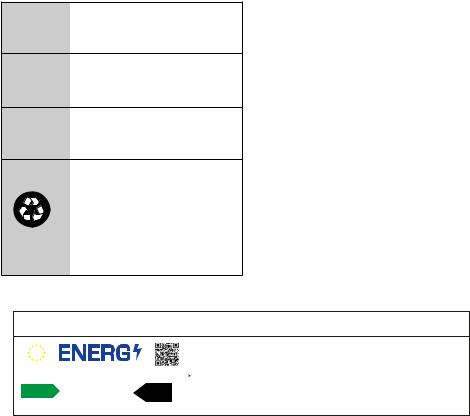
Veuillez d’abord lire ce manuel d’utilisation !
Chère cliente, cher client,
Nous aimerions que vous soyez entièrement satisfait de notre appareil, fabriqué dans des infrastructures modernes et ayant fait l'objet d'un contrôle de qualité minutieux.
À cet effet, veuillez lire en intégralité le manuel d'utilisation avant d'utiliser cet appareil, et conservez-le pour références ultérieures. Si vous offrez cet appareil à une autre personne, remettez-lui également le manuel d'utilisation.
Le manuel d'utilisation garantit l'utilisation rapide et sécurisée du réfrigérateur.
•Veuillez lire le manuel d'utilisation avant d'installer et d'utiliser le réfrigérateur,
•Respectez toujours les instructions de sécurité en vigueur,
•Tenez le manuel d'utilisation à portée pour références ultérieures,
•Veuillez lire tous les autres documents fournis avec l'appareil,
Veuillez noter que ce manuel d'utilisation peut se rapporter à plusieurs modèles de cet appareil. Le manuel indique clairement toutes les différences entre les modèles.
Symboles et commentaires
Les symboles suivants sont utilisés dans le manuel d'utilisation :
C Informations importantes et renseignements utiles,
A Avertissement relatif aux conditions dangereuses pour la vie et la propriété,
B Risque d'électrocution,
L'emballage de l'appareil a été fabriqué à partir de matériaux recyclables, conformément à la législation nationale en matière d'environnement,
C INFORMATIONS
|
|
|
|
|
|
|
Vous pouvez accéder aux informations relatives au modèle |
|
|
|
|
|
|
|
|
|
|
|
|
|
|
|
telles que sauvegardées dans la base de données des pro- |
|
|
|
|
|
|
|
duits en entrant le site internet suivant et en recherchant |
|
|
|
|
|
|
|
|
|
SUPPLIER’S NAME |
MODEL IDENTIFIER |
|
|
|
(*) l'identifiant de votre modèle (*) qui se trouve sur la vignette |
|
|
|
|
|||||
|
A |
A |
|
|
énergie |
||
|
|
|
|
|
|
|
|
|
|
|
|
|
|
|
https://eprel.ec.europa.eu/ |
|
|
|
|
|
|
||

Table des matières
1 Consignes importantes relatives à la |
|
sécurité et à l’environnement |
4 |
1.1. Sécurité générale . . . . . . . . . . . . . . . . . . . . 4
1.1.1Mise en garde concernant les hydrocarbures6
1.1.2Pour les appareils avec distributeur d’eau/
machine à glaçons. . . . . . . . . . . . . . . . . . . 7 1.2. Utilisation préconisée. . . . . . . . . . . . . . . . . . 7 1.3. Sécurité des enfants . . . . . . . . . . . . . . . . . . 7
1.4. Conformité avec la directive DEEE et mise au rebut de l’appareil usagé : . . . . . . . . . . . . . 8
1.5. Conformité avec la directive LdSD : . . . . . . . 8 1.6. Informations relatives à l’emballage . . . . . . . 8
2 Votre réfrigérateur |
10 |
|
|
3 Installation |
11 |
3.1. Lieu idéal d'installation . . . . . . . . . . . . . . . 11 3.2. Fixation des cales en plastique. . . . . . . . . . 11 3.3. Réglage des pieds. . . . . . . . . . . . . . . . . . . 11 3.4. Branchement électrique . . . . . . . . . . . . . . 12
4 Préparation |
13 |
4.1. Moyens d'économiser l'énergie . . . . . . . . . 13 4.2. Première utilisation . . . . . . . . . . . . . . . . . . 13
5 Utilisation de l'appareil |
15 |
5.1. Ecran de contrôle . . . . . . . . . . . . . . . . . . . 15 5.3. Support d'œufs . . . . . . . . . . . . . . . . . . . . . 18 5.2. Seau à glace. . . . . . . . . . . . . . . . . . . . . . . 18 5.6. Compartiment zéro degré . . . . . . . . . . . . . 18 5.5. Bac à légumes . . . . . . . . . . . . . . . . . . . . . 18 5.4. Ventilateur . . . . . . . . . . . . . . . . . . . . . . . . 18
5.7. Utilisation du deuxième bac à lègumes de l’appareil; . . . . . . . . . . . . . . . . . . . . . . . . 19
5.8. Balconnet de porte amovible . . . . . . . . . . . 20 5.9. Boîte de stockage coulissante . . . . . . . . . . 20 5.10. Bac à légumes à humidité contrôlée . . . . . 21 5.11. Module de désodorisation . . . . . . . . . . . . 21 5.12. Machine à glace automatique . . . . . . . . . 22
5.13. Distributeur et récipient de conservation de glaçons . . . . . . . . . . . . . . . . . . . . . . . . . . 23
(dans certains modèles) . . . . . . . . . . . . . . . . . . 23 5.14. Distributeur d’eau . . . . . . . . . . . . . . . . . . 24 5.15. Utilisation du distributeur . . . . . . . . . . . . . 24 5.16. Nettoyer le réservoir d’eau . . . . . . . . . . . . 25 5.17. Bac à eau . . . . . . . . . . . . . . . . . . . . . . . . 26 5.18. Congélation des produits frais. . . . . . . . . . 27
5.19. Recommandations relatives à la conservation des aliments congelés . . . . . . . . . . . . . . . 27
5.20. lnformations relatives au congélateur . . . . 28 5.21. Disposition des denrées . . . . . . . . . . . . . . 28 5.22. Alerte ouverture de porte . . . . . . . . . . . . . 28
5.23. Inversion de la direction d’ouverture de la porte . . . . . . . . . . . . . . . . . . . . . . . . . . . . 28
5.24. Éclairage interne . . . . . . . . . . . . . . . . . . . 28 5.25. Lumière bleue/HarvestFresh. . . . . . . . . . . 29
5.26 Le compartiment des produits laitiers (entrepôt frigorifique) . . . . . . . . . . . . . . . . . . . . . . . 29
6 Entretien et nettoyage |
30 |
6.1. Prévention des mauvaises odeurs . . . . . . . 30 6.2. Protection des surfaces en plastique. . . . . 31 6.3. Nettoyage de la surface intérieure . . . . . . . 31 6.4. Surfaces extérieures en acier inoxydable . . 31 6.5. Nettoyage d’appareils avec portes en verre 31
6 |
Entretien et nettoyage |
31 |
7 |
Dépannage |
32 |
|
|
|
Réfrigérateur / Manuel d’utilisation |
3/42FR |
|

1 Consignes importantes relatives à la sécurité et à l’environnement
Cette section comporte des informations de sécurité qui vous aideront à éviter les risques de blessures ou de dommages matériels. Le non-respect de ces instructions entraîne l’annulation de la garantie des appareils.
Utilisation Préconisée
AVERTISSEMENT:
Assurez-vous que les trous A d’aération ne sont pas
fermés quand le dispositif est dans son boîtier ou est installé à sa place.
AVERTISSEMENT:
Ne pas utiliser tout A dispositif mécanique ou
un autre dispositif hors des recommandations du fabricant pour accélérer le processus de décongeler.
AVERTISSEMENT:
A Ne pas endommager le circuit de fluide du réfrigérateur.
AVERTISSEMENT:
Ne pas utiliser des appareils A électriques non prévus
par le fabricant dans les compartiments de
conservation des aliments.
AVERTISSEMENT:
Ne conservez pas de A substances explosives
comme des aérosols avec un liquide inflammable dans cet appareil.
Ce dispositif est conçu pour l’usage domestique ou les applications similaires suivantes :
-Pour être utilisé dans la cuisine de personnel dans les magasins, bureaux et autres environnements de travail ;
-Pour être utilisé par les clients dans les maisons de campagne et hôtels et les autres environnements d’hébergement ;
-Dans des environnements de type de pension de famille
-Dans des applications similaires n’ayant pas de service alimentaire et non détaillants
1.1. Sécurité générale
•Les personnes présentant un handicap physique, sensoriel ou mental ou encore celles manquant d’expérience ou de connaissances appropriées, ou les enfants doivent éviter d’utiliser, de se rapprocher, de jouer ou de rentrer à l’intérieur de ce produit.
•L’utilisation non contrôlée et le nonrespect des consignes énoncées cidessus constituent un réel danger !
•Débranchez l’appareil si une panne survient alors qu'il est en cours d’utilisation.
•En cas de dysfonctionnement, n’utilisez pas l’appareil jusqu’à ce qu’il soit réparé par un agent de service agréé. Risque de choc électrique !
•Branchez l’appareil à une prise mise à la terre, protégée par un fusible conforme aux valeurs figurant sur la plaque signalétique. Faites appel à un électricien qualifié pour la mise à la terre de l’appareil. Notre société ne peut pas être tenue pour responsable des dommages résultant de la non utilisation du produit avec une prise mise à la terre conformément aux réglementations locales.
•Débranchez l'appareil lorsque vous ne l'utilisez pas.
|
4 /42FR |
Réfrigérateur / Manuel d’utilisation |
|
|
|
|
|
|
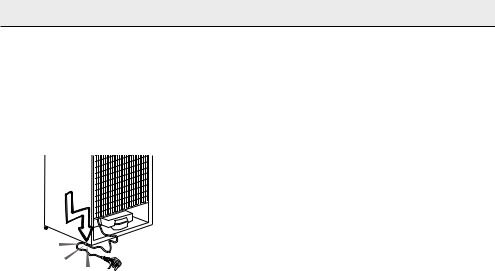
Instructions en matière de sécurité et d'environnement
• N'aspergez pas l'appareil et n'y |
• |
Ne touchez pas les aliments |
|||
versez pas de l'eau lorsque vous le |
|
congelés avec les mains mouillées ! |
|||
lavez! Risque de choc électrique ! |
|
Ils peuvent coller à vos mains ! |
|||
• Ne touchez jamais la prise avec des |
• |
Ne posez pas de boissons en |
|||
mains mouillées ! |
|
bouteilles ou en cannettes dans |
|||
• Ne débranchez jamais l’appareil en |
|
le congélateur. Elles risquent |
|||
tirant sur le câble. Débranchez-le |
|
d'exploser ! |
|||
toujours en le tenant par la fiche. |
• |
N'utilisez jamais de vapeur ni de |
|||
|
|
|
|
matériel de nettoyage à vapeur |
|
|
|
|
|
||
|
|
|
|
pour nettoyer ou décongeler le |
|
|
|
|
|
réfrigérateur Tout contact entre |
|
|
|
|
|
la vapeur et les éléments sous |
|
|
|
|
|
tension de votre réfrigérateur peut |
|
|
|
|
|
entraîner un court-circuit ou un choc |
|
|
|
|
|
électrique ! |
|
|
|
|
• Pour accélérer le processus de |
||
|
|
|
|||
• Évitez de brancher le réfrigérateur |
|
décongélation, n’utilisez pas d’outils |
|||
|
mécaniques ou de dispositifs autres |
||||
lorsque la prise de courant est mal |
|
||||
|
que ceux recommandés par le |
||||
fixée. |
|
||||
|
fabricant. |
||||
• Ne branchez jamais votre |
|
||||
• |
N'utilisez jamais les pièces de votre |
||||
réfrigérateur à des systèmes |
|||||
|
réfrigérateur telles que la porte et |
||||
d'économies d'énergie. Ces systèmes |
|
||||
|
le tiroir, comme un support ou une |
||||
présentent des risques pour votre |
|
||||
|
marche. Une telle utilisation de |
||||
appareil. |
|
||||
|
l’appareil peut l'emmener à balancer |
||||
• Débranchez l’appareil pendant les |
|
||||
|
ou endommager ses parties. |
||||
procédures d'installation, d'entretien, |
|
||||
• |
Évitez d’endommager les pièces où |
||||
du nettoyage et de réparation. |
|||||
|
circule le liquide réfrigérant avec des |
||||
• Contactez toujours un Agent de |
|
||||
|
outils de perforation ou de coupe. |
||||
service agréé pour l’installation |
|
||||
|
Le liquide réfrigérant qui pourrait |
||||
de l’appareil et la réalisation des |
|
||||
|
s’échapper si les canalisations de |
||||
branchements électriques. Le |
|
||||
|
gaz de l’évaporateur, les rallonges |
||||
fabricant décline toute responsabilité |
|
||||
|
de tuyau ou les revêtements de |
||||
pour les dommages causés par la |
|
||||
|
surface étaient percés, peut irriter |
||||
réalisation de ces procédures par des |
|
||||
|
la peau et provoquer des blessures |
||||
personnes non autorisées. |
|
||||
|
aux yeux. |
||||
• Ne mangez pas de cônes de |
|
||||
• |
Ne laissez aucun objet couvrir ou |
||||
crème glacée ou des glaçons |
|||||
|
obstruer les orifices de ventilation |
||||
immédiatement après les avoir sortis |
|
||||
|
du réfrigérateur. |
||||
du compartiment de congélation ! |
|
||||
• |
Placez les boissons alcoolisées |
||||
Cela pourrait provoquer des |
|||||
engelures dans votre bouche ! |
verticalement, dans des récipients |
|
convenablement fermés. |
||
|
Réfrigérateur / Manuel d'utilisation |
5/42FR |
|
